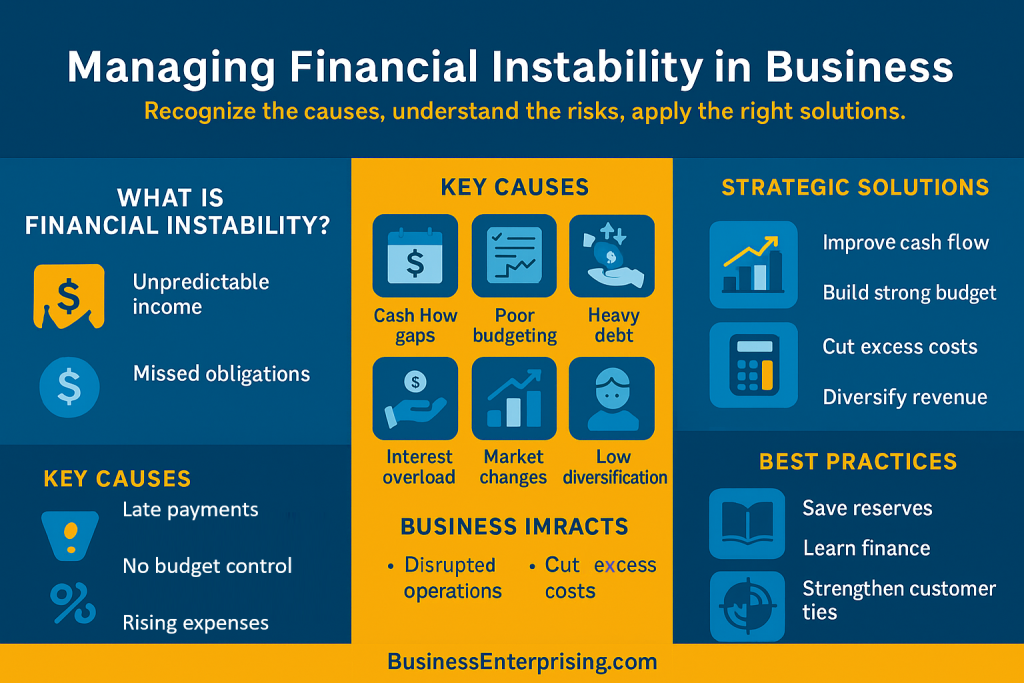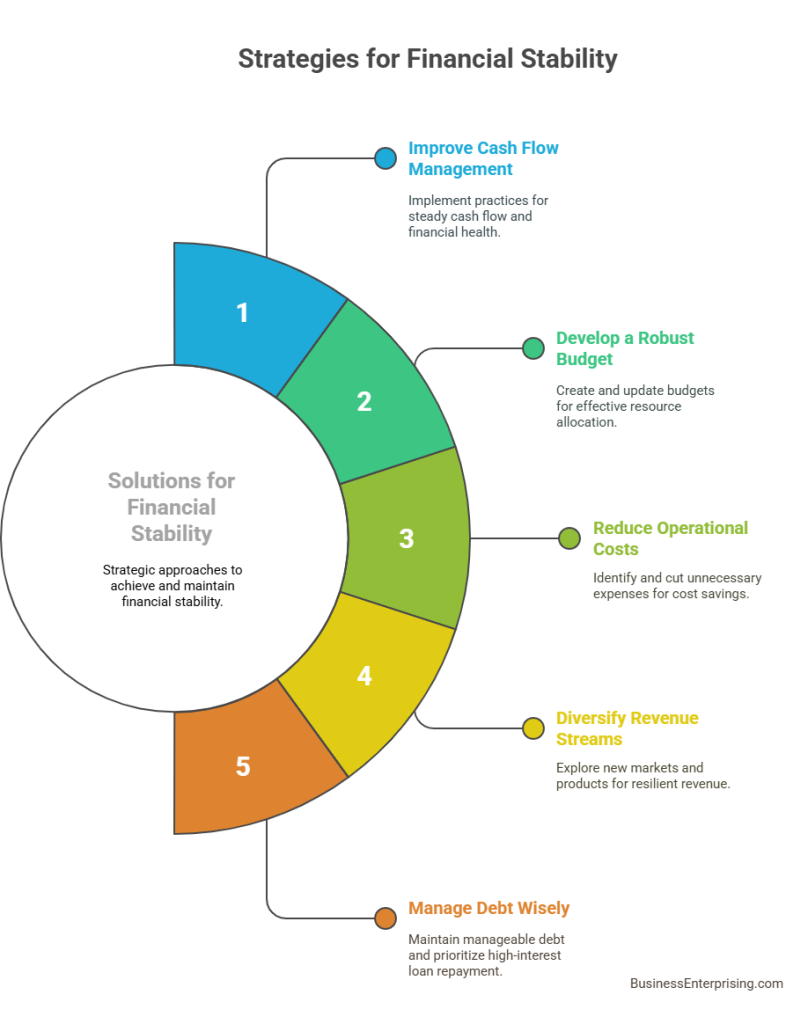Managing financial instability is a common challenge that can threaten the survival and growth of any business, regardless of its size or industry. It manifests as unpredictable revenue streams, inability to meet financial obligations, and overall uncertainty about the financial future. Addressing financial instability is crucial for maintaining business operations, fostering growth, and ensuring long-term sustainability.
Understanding Financial Instability
Financial instability in business occurs when there is a lack of consistent and reliable income to cover expenses and invest in growth opportunities. This instability can stem from various internal and external factors, creating a precarious financial environment that hinders business performance.
Causes of Financial Instability
Several factors can contribute to financial instability in a business:
Inconsistent Cash Flow: Variations in cash inflow and outflow can create financial instability. This inconsistency can result from seasonal sales fluctuations, delayed customer payments, or unexpected expenses.
Poor Financial Management: Additionally, inadequate financial planning, budgeting, and oversight can also lead to financial mismanagement. Without a clear understanding of income and expenses, businesses may struggle to maintain financial stability.
High Operational Costs: Excessive operational costs, including rent, utilities, payroll, and inventory, can strain financial resources. When expenses consistently exceed revenue, financial instability ensues.
Debt and Interest Obligations: High levels of debt and associated interest payments can drain financial resources, leaving little room for investment or savings. Debt can quickly become unmanageable, leading to financial instability.
Market Volatility: Changes in market conditions, such as economic downturns, shifts in consumer preferences, and increased competition, can impact revenue streams and create financial uncertainty.
Lack of Diversification: Relying on a single source of income or a limited customer base can increase vulnerability to financial instability. Diversification is essential for mitigating risks and ensuring steady revenue.
Impacts of Financial Instability
The consequences of financial instability can be far-reaching and detrimental to a business:
Operational Disruptions: Financial instability can disrupt day-to-day operations, making it difficult to cover essential expenses such as payroll, rent, and utilities. This can affect productivity and overall business performance.
Inability to Grow: Without financial stability, investing in growth opportunities, such as expanding operations, launching new products, or entering new markets, becomes challenging.
Loss of Creditworthiness: Financial instability can damage a business’s creditworthiness, making it difficult to secure loans or attract investors. Poor credit ratings can limit access to necessary capital.
Employee Turnover: Financial instability can lead to delayed or reduced payroll, causing employee dissatisfaction and turnover. High employee turnover can further disrupt operations and affect morale.
Stress and Uncertainty: Persistent financial instability creates a stressful environment for business owners and employees. This stress can affect decision-making, creativity, and overall well-being.
Solutions for Resolving Financial Instability
Addressing financial instability requires a strategic and proactive approach. Here are several solutions to help businesses achieve and maintain financial stability:
Improve Cash Flow Management: Effective cash flow management is essential for financial stability. Implement practices such as accurate cash flow forecasting, timely invoicing, and efficient accounts receivable processes to ensure a steady flow of funds.
Develop a Robust Budget: A well-structured budget provides a clear overview of expected income and expenses. Regularly review and update the budget to reflect changes in revenue and costs. Budgeting helps businesses allocate resources effectively and avoid overspending.
Reduce Operational Costs: Identify and eliminate unnecessary expenses to reduce operational costs. Conduct regular expense audits to find areas for cost savings, such as renegotiating supplier contracts, optimizing energy usage, and streamlining processes.
Diversify Revenue Streams: Diversifying income sources can also mitigate the risk of financial instability. Explore new markets, introduce new products or services, and seek additional revenue channels to create a more resilient business model.
Manage Debt Wisely: Above all, maintain a manageable level of debt and prioritize paying down high-interest loans. Develop a debt repayment plan and explore refinancing options to reduce interest obligations. Avoid taking on unnecessary debt that could strain financial resources.
Best Practices
Build a Financial Cushion: Establish a financial reserve or emergency fund to cover unexpected expenses and cash flow gaps. Setting aside a portion of profits during profitable periods can provide a safety net during challenging times.
Enhance Financial Literacy: Improving financial literacy among business owners and key employees can enhance financial management. Invest in training and education to better understand financial statements, budgeting, and cash flow management.
Seek Professional Advice: Consulting with financial advisors, accountants, or business consultants can provide valuable insights and strategies for managing financial instability. Professional advice can help identify underlying issues and develop tailored solutions.
Strengthen Customer Relationships: Building strong relationships with customers can lead to more reliable and timely payments. Implement customer loyalty programs, offer incentives for early payments, and provide excellent customer service to encourage repeat business.
Monitor and Adapt: Lastly, regularly monitor financial performance and market conditions to identify potential issues early. Be prepared to adapt strategies and make necessary adjustments to maintain financial stability.
Managing financial instability is a significant challenge that can impede business growth and sustainability. However, with proactive planning, effective financial management, and strategic decision-making, businesses can overcome financial instability and build a stable financial foundation. By improving cash flow management, reducing operational costs, diversifying revenue streams, and seeking professional advice, businesses can navigate financial challenges and achieve long-term success. Maintaining financial stability requires continuous vigilance and adaptability, but the rewards of a stable and thriving business make the effort worthwhile.


